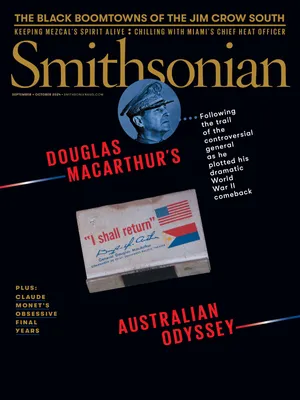How the Hirshhorn Museum Went From Iconoclast to Icon
Celebrating 50 years of the modernist masterpiece that shocked critics—and helped turn Washington into an arts capital
:focal(2016x1517:2017x1518)/https://tf-cmsv2-smithsonianmag-media.s3.amazonaws.com/filer_public/62/89/62893fd1-5fa6-4343-bc1b-c02c2d91c26d/hirshhorn_rb.jpg)
Immediately after the 1969 groundbreaking for the Hirshhorn Museum and Sculpture Garden in Washington, D.C., Ada Louise Huxtable, then architecture critic for the New York Times, described the planned building as “the biggest marble doughnut in the world.” By the time the museum opened to the public a good five years later—a cylinder 231 feet across clad in concrete panels, hovering like an alien spacecraft alongside a sunken sculpture garden at the southern edge of the National Mall—critical opinion hadn’t softened. Paul Goldberger, in the Times, called it “a gesture of urbanistic arrogance,” while Harold Rosenberg, writing for the New Yorker, compared it, improbably, to “an illuminated babka.”
Designed by New York-based architect Gordon Bunshaft of Skidmore, Owings & Merrill, the Hirshhorn could hardly have seemed more out of place, just a block from the respectable neo-Classical pastiche of 1941’s National Gallery of Art and less than 4,000 feet west of the Capitol’s imperial pomp. With time, though, the building’s brashness made it an ideal home for one of midcentury America’s most significant private collections of modern art.
Until 1962, when the Guggenheim in New York mounted a major exhibition called “Modern Sculpture From the Joseph H. Hirshhorn Collection,” virtually no one knew the brilliance, scope or scale of the mining magnate’s collection. Born into poverty in Latvia, Hirshhorn emigrated to the U.S. at age 6, started working as a newsboy at 13 and, from the 1930s onward, made a fortune speculating in gold, oil and uranium in Canada; within a decade, he’d begun to accumulate serious art, eventually building a collection of some 11,500 precious items. At the Guggenheim, 444 sculptures from Hirshhorn’s holdings by the likes of Brâncuşi, Rodin, Picasso and Arp cascaded down the ramp of Frank Lloyd Wright’s iconic Fifth Avenue Building. Soon, dignitaries from Beverly Hills to Baltimore, Italy to Israel, began courting Hirshhorn, hoping to secure his collection. But when S. Dillon Ripley, Secretary of the Smithsonian, and President Lyndon B. Johnson offered Hirshhorn a place on the Mall in 1966, the magnate agreed to give 6,000 works to the Smithsonian. With the Hirshhorn donation, Ripley hoped Washington would become an “art capital, second only to New York.”
For decades, neoclassicism had ruled as the capital’s official style, and though modernism began creeping into the city’s residential, commercial and diplomatic architecture during the post-World War II boom years, it wasn’t until the 1960s that federal tastes formally shifted. In 1963, President John F. Kennedy appointed Bunshaft to the U.S. Commission of Fine Arts (CFA), which reviewed proposals for new federal buildings. Bunshaft helped usher in such Brutalist monuments as Marcel Breuer’s Department of Housing and Urban Development and Charles F. Murphy’s FBI headquarters. When he presented his plans for the Hirshhorn, Bunshaft described the building as “a piece of sculpture,” its curving concrete piers “growing out like a tree.”
Despite its reception, the Hirshhorn marked a transformative moment for the Mall. What had been, in Huxtable’s unforgettable description, “a brontosaurian marble boneyard” evolved into an eclectic showcase for contemporary design, from Maya Lin’s lacerating Vietnam Veterans Memorial to the sobering grandeur of David Adjaye’s National Museum of African American History and Culture.
/https://tf-cmsv2-smithsonianmag-media.s3.amazonaws.com/filer_public/f8/36/f836bc07-638f-4eca-849b-115b037696b9/imgl8680.jpg)
Within a decade of the Hirshhorn’s completion 50 years ago, in 1974, landscape architect Lester Collins refurbished the original sculpture garden with trees and shrubs to provide shade in the harsh Washington summers, and, more recently, a café and seating area, designed by artist and architect Hiroshi Sugimoto, were added to the ground floor. “It’s such a serene experience when you’re there,” says Mary Fitch, executive director of the Washington branch of the American Institute of Architects. Yet the museum’s programming has only become bolder. Since the late 1980s, the Hirshhorn’s “Directions” series has showcased artists like Cindy Sherman, Glenn Ligon and Shahzia Sikander, offering some their first big break. As the museum’s current director, Melissa Chiu, puts it, “We’re always talking about how to capture the zeitgeist.” Since the early 2000s, that has included projecting films onto the museum’s curved exterior and, under Chiu, commissioning site-specific works from contemporary luminaries like Robert Irwin and Laurie Anderson, who installed the first survey-exhibition of her polymathic career there in 2021.
But there may be no greater proof of the Hirshhorn’s relevance than its ongoing ability to stir controversy. In 2021, plans for Sugimoto to renovate the museum’s sculpture garden sparked outrage among architectural conservationists, who saw proposed new elements—including a new reflecting pool and platform for performances, and a stacked-stone partition wall—as anachronistic intrusions on a central work of D.C. modernism. (The new garden, with CFA’s stamp of approval, is set to open in 2026.) Bunshaft’s iconoclastic building has become, perhaps ironically, a monument.
For Chiu, such changes are essential. “We’re fully engaged in revising the 20th-century art history that we were all taught,” Chiu says. Far from the “boneyard” that Huxtable described, the Hirshhorn has proved a vital part of the capital’s cultural life—a lively, delightful garden, fertile with bold ideas.


